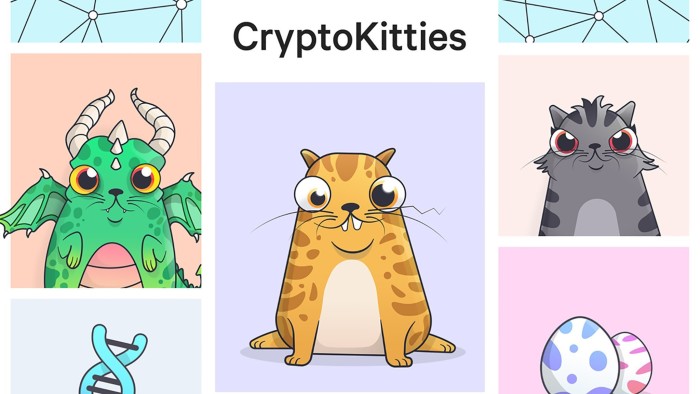CryptoKitties, CryptoPunks and the birth of a cottage industry

Roula Khalaf, Editor of the FT, selects her favourite stories in this weekly newsletter.
Seth Spalding, a portfolio manager at investment firm Passport Capital and a former vice-president of investment bank Goldman Sachs, is amassing an art collection. But you will not find paintings at his home in San Francisco, or sculptures in storage. The art Mr Spalding owns does not exist anywhere, as such. His carefully curated collection is digital — works that exist on the cryptographically secured technology known as blockchain.
“The concept that we’ve all grown up with, about digital stuff, is that it’s ephemeral, it can be wiped off your hard drive . . . it’s worthless because it can be copied infinitely at incremental cost,” says Mr Spalding. “But blockchain allows you for the first time to create digital scarcity [which] tips the whole idea on its head.”
Mr Spalding is part of a vanguard of enthusiasts curious about blockchain’s novel potential to affix value to digital art by making it rare and unreplicable. Riding a wave of interest in cryptocurrency, a new industry of digital collectibles sees blockchain art and other digital items created and traded for cryptocurrencies such as bitcoin and ether, the digital money associated with the Ethereum blockchain.
Among the cryptocurrency-wealthy there are willing buyers — one digital cat, which was part of a game called CryptoKitties, sold last month for the cryptocurrency equivalent of $140,000.
Mr Spalding collects unique digital pictures called CryptoPunks — his favourite of the tiny pixelated faces has 3D glasses and a Mohican hair style — as well as Curio Cards, which are small digital artworks hosted on blockchain, often featuring graffiti styles and lurid colours.
Computer gamers have been collecting virtual items inside games for years, spending money on better weapons, or gold to use in the digital world. Many gamers would, for example, spend money on “a costume or skin that you put on your character,” says David Pekar, co-founder and chief executive of Rare Bits, an online marketplace for blockchain items, which has raised $6m in a fundraising, according to TechCrunch. A “rare and beautiful” costume confers “gravitas as you move through the digital world”, he says.
While you might pay for those items, however, you never exactly own them. Virtual swords could be deleted from the centralised server by the developers who made the computer game. Blockchain technology, by contrast, is decentralised, meaning no single entity controls it. If your digital item is stored on a blockchain, “the property that you buy actually holds a lot more value because it can’t be taken away from you”, says Mr Pekar — although it can be stolen by hackers.

John Watkinson, a Canadian software developer who works for a small digital agency, was behind the first blockchain collectible project. “I had collected everything from hockey cards and magic cards when I was a teenager,” says Mr Watkinson. But creating the digital equivalent of paintings and baseball cards posed a difficulty: “Is it too easy to copy?”
Mr Watkinson and his partner “stumbled across the idea of using blockchain” to make digital collectibles in early 2017. They created simple pixel faces, and wrote their code into tokens on the Ethereum blockchain. Each of these CryptoPunk characters was unique, and because the cryptographic tokens cannot be copied, the CryptoPunks were safe from duplication.
“I wrote a [CryptoPunk] generator,” says Mr Watkinson. “There are stock faces . . . including some rare ones like a zombie, ape and alien.” To that he added accessories including hats, sunglasses and earrings, with an algorithm that combines them.
It was an experiment, he says. “We posted it to some of the forums and newsboards . . . initially we were giving it away.” After paying a small transaction fee, the CryptoPunk token would be transferred to your cryptocurrency wallet, the public blockchain record proving your ownership.
Just 20 or 30 of the 10,000 free CryptoPunks were claimed that Friday. “We were starting to think, ah no, this doesn’t really have it,” he says. That changed when the website Mashable ran a story about the CryptoPunks.
Mr Watkinson recalls that “by Saturday morning they had all been claimed. In one night everyone had gone crazy.” A secondary market quickly appeared, with buyers trading the tokens in exchange for ether. One sold on that Saturday for 10 ether, equivalent to, at that time, $3,500. “That was just sort of astounding,” says Mr Watkinson.

The most expensive CryptoPunk yet sold was an alien, a rare variety that went for the equivalent of $16,000, according to Mr Watkinson.
Newly minted cryptocurrency millionaires are a “pretty spendy crew”, he adds. “Not to compare our project with Andy Warhol, but it’s this kind of thing where people dismiss it because it seems easily copiable.” Yet other digital art and collectibles are growing on blockchains. CryptoKitties, which is also based on Ethereum, are attracting millions of virtual dollars and the websites DADA and the R.A.R.E. Digital Art Network are trying something similar.
Elsewhere, the Rare Pepe Wallet facilitates the purchase of scarce Pepe memes — the green frog associated with the alt-right movement in the United States. At a rare digital art festival in New York in January, one image in a live auction — the Homer Pepe — sold for the equivalent of $39,000.
But digital art has drawbacks. “You can’t easily hang it on your wall,” says Mr Watkinson. But he adds, “you don’t have to get Christie’s involved and 50 per cent of the value is gone to them if you sell it”.
Actually, Christie’s does want to get involved. The auction house is holding a summit in July to “explore the potential applications of blockchain within the art market”, according to its website.
One application is provided by Codex Protocol, a business that aims to store provenance documentation privately on blockchain. A cryptographic key would, in theory, allow an art piece’s holder to share information about the work with insurers or galleries who need to see documentation. This would make the art piece easier to trace and make its paper trail more secure, in a similar way to initiatives in use in the luxury watch market.
“If it was just a database, people would have to still trust us,” says Jess Houlgrave, Codex’s co-founder and chief operating officer. “With Codex on the blockchain, even we can’t see it.”
It is not clear how well blockchain art will hold its value but Mr Spalding is hopeful that his early entry into digital collecting will have historic value, at least. “Time is the ultimate blockchain,” he says.

Comments